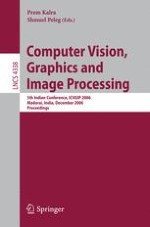The Indian Conference on Computer Vision, Graphics and Image Processing (ICVGIP) is a forum bringing together researchers and practitioners in these related areas, coming from national and international academic institutes, from government research and development laboratories, and from industry. ICVGIP has been held biannually since its inception in 1998, attracting more participants every year, including international participants. The proceedings of ICVGIP 2006, published in Springer's series Lecture Notes in Computer Science, comprise 85 papers that were selected for presentation from 284 papers, which were submitted from all over the world. Twenty-nine papers were oral presentations, and 56 papers were presented as posters. For the first time in ICVGIP, the review process was double-blind as common in the major international conferences. Each submitted paper was assigned at least three reviewers who are experts in the relevant area. It was difficult to select such a few papers, as there were many other deserving, but those could not be accommodated.
